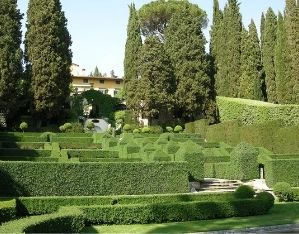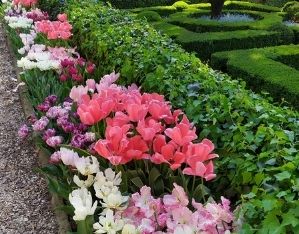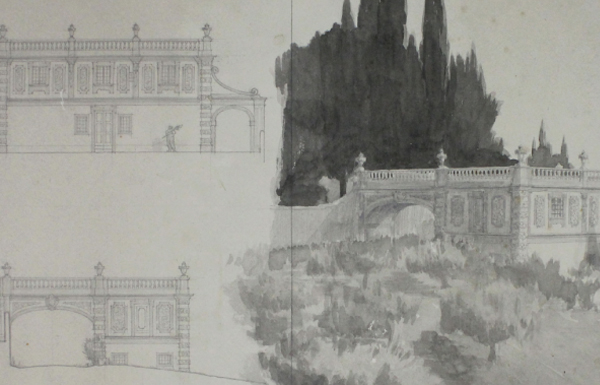The garden of an early 20th-century well-known art critic and historian, designed by a great architect, conceived as a large “camera di verzura”: an outdoor greenery room with a rigorous geometrical layout working as an extension of the house.
Villa “I Tatti” is one of the first “Italian gardens” with a clear revival spirit, interpreting the formal harmony of the gardens of the past. An idea that was shared by numerous intellectuals of the refined and cultured English community that at during the early 20th century had settled in a number of villas around Florence. Soon after his arrival in Italy, English architect and landscaper Cecil Pinsent was appointed by Bernard Berenson and his wife Mary to supervise the work they were carrying out on their property in collaboration with architecture historian Geoffrey Scott. The renovation work begun in 1911, and finished a few years later following an extraordinary reinvention of a skilfully structured garden based on a fine mastering of the art of topiary. The terraced levels with garden beds are bordered on both sides by tall cypress hedges. The boxwood shrubs trace refined geometric patterns and a series of pinnacles add rhythm to the space defined by the tall hedges. No concessions are made to colour in this garden celebrating the sculptural-decorative value of geometrically domesticated plants. At the end of the terraces a double stairway leads to the “selvatico” holm oak wood. Parallel to the garden on the east side, a wide path takes to a rustic grotto.
Highlights

The "parterre"
Cecil Pinsent's true masterpiece, this magnificent geometric “parterre” is laid out to be admired in all its splendour: four slightly sloping terraces peacefully descending towards the valley, leading to the last section where the central path transitions into a lawn.

The “mixed borders”
Some of the best-kept mixed borders to be seen in the Florentine gardens can be admired in this garden: an excellent selection of annual and perennial blooms handpicked every year by head-gardener Margit Freivogel.

Harvard University
In 1959 the villa, together with the entire property, was donated to Harvard University where Berenson had studied. In 1961 Villa I Tatti became the Harvard University Center for Italian Renaissance Studies.
Find out more
Gardens of the twentieth century
Born in Uruguay into a wealthy British family Pinsent eventually moved to Europe where he became the architect that in the first half of the 20th century worked more than any other for the Anglo-Florentine community creating new gardens and transforming existing ones.

 Villa I Tatti
Contacts
Villa I Tatti
Contacts
Contacts
Other contacts::To receive information, please fill out the form on the website.
Address
Via Vincigliata, 26
50014, Fiesole (FI)
 Villa I Tatti
Opening times and prices
Villa I Tatti
Opening times and prices
Opening hours
General public
VillaI Tatti is a research centre and offers a series of tours for the public throughout the academic year. Places are limited (max. 8 people) and tours are offered in English. Tours are for audiences over the age of 12. May, June, September and October are very busy months, so it is advisable to book your visit well in advance. Tours of the Villa and gardens are not available in July, August and early September. Tours are suspended during winter break, on holidays, and on days when study center events are taking place. Harvard Alumni and Renaissance Scholars
Harvard students and alumni and Renaissance scholars may request to tour the Villa, its collections, and garden. Tours are only on Tuesday and Wednesday afternoons at 3pm. Tours are offered in English and seating is limited (max. 8 people).
 Villa I Tatti
How to get there
Villa I Tatti
How to get there
Address
Via Vincigliata, 26
50014, Fiesole (FI)
Latitude: 43.7866623
Longitude: 11.3093471
How to arrive by road
Take the motorway towards Florence, following the signs for the Firenze Sud exit. Exit at Firenze Sud and cross the bridge over the Arno river. At the first traffic light turn left into Via De Nicola. At the roundabout with the fountain, turn right into Via della Casaccia and continue straight through four roundabouts. At the fifth one turn right into Via Palazzeschi and, at a small roundabout at the end, turn left into Via della Torre. Then turn right into Via Gabriele D’Annunzio and take the first left (immediately after Trattoria Osvaldo) into Via di Vincigliata. Go straight for about 700 meters until you reach number 43 and park in the field just inside the gate. Walk for about 100 metres to number 22 and ring the bell of the Library.
How to arrive by train
From the Florence train station, Santa Maria Novella, take the ATAF bus 1, 6, 17 or 23 to Piazza San Marco.
How to arrive by bus
From Piazza San Marco take the 10 ATAF bus to Ponte a Mensola. Once off the bus, use the crosswalk to cross the street and continue on Via Gabriele D’Annunzio. Take the first left (immediately after Trattoria Osvaldo) into Via di Vincigliata and continue up the hill for about 800 mt, pass gate 43 (on the right) and go up to gate 22 (on the left). The walk takes about 10/15 minutes.
Additional directions
For those arriving from Florence airport, take the Airport Shuttle Bus, ATAF Volainbus, to the central train station, Santa Maria Novella.
 Villa I Tatti
Services/Accessibility
Villa I Tatti
Services/Accessibility
Services
Parking is available in the field along the right side of Via di Vincigliata 43, please ring the gate. The alternative is to park near Ponte a Mensola or along Via di Vincigliata or in Via di San Martino a Mensola. Parking is not guarded. Gates close at 8:30 pm. The only vehicles allowed to enter Gate 22 are taxis bringing or picking up guests.
 Villa I Tatti
Private events
Villa I Tatti
Private events
 Villa I Tatti
Itineraries
Villa I Tatti
Itineraries
You could find the garden in these itineraries
 Favorite saving result
Favorite saving result
 Warning!
Warning!
You've have to sign up or sign in to add this element to your favorites.
